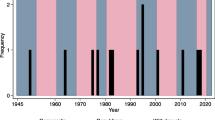Abstract
An alternative interpretation of the Ross-Dunlop debate of the 1940s is provided, which reveals little difference in the opinions of these two theorists on the role of optimizing behavior and of economic factors in explaining trade union behavior. Importantly, both saw theories of union activity based on simple economic maximands as unable to incorporate some “political” features of those unions. The recent wave of economic analyses of trade unions however seems to have answered such criticism to a large extent. A survey of this work is provided to show how many of Ross’s “unanswered questions” can be explained by models where rational trade unions maximize relatively straightforward objective functions.
Similar content being viewed by others
Bibliography
Alchian, A. A. and H. Demsetz. “Production, Information Costs and Economic Organization.”American Economic Review 62 (1972): 777–95.
Addison, J. T. “The Role of Comparability in Wage Determination.”British Journal of Industrial Relations 13 (1975): 388–95.
Akerlof, G. A. “Labor Contracts as Partial Gift Exchange.”Quarterly Journal of Economics 97 (1982): 543–69.
Ashenfelter, O. C. and G. E. Johnson. “Bargaining Theory, Trade Unions and Industrial Strike Activity.”American Economic Review 59 (1969): 35–49.
Atherton, W.The Theory of Union Bargaining Goals. Princeton: Princeton University Press, 1973.
Blair, D. and D. Crawford. “Labor Union Objectives and Collective Bargaining.”Quarterly Journal of Economics 99 (1984): 547–66.
Booth, A. “A Public Choice Model of Trade Union Behavior and Membership.”Economic Journal 94 (1984): 883–898.
Borland, J. “Aspects of the Economics of Trade Unions,” M.A. thesis, Department of Economics, University of Melbourne, 1984.
_____. “A Principal-Agent Model of Trade Union Behaviour.” Working Paper No. 135, Department of Economics, University of Melbourne, 1985a.
_____. “Trade Unions, Money Wage Rigidity and the Absence of Indexation.” Mimeo, University of Melbourne, 1985b.
Burton, J. “The Economic Analysis of the Trade Union as a Political Institution.” In J. J. Rosa (ed.),The Economics of Trade Unions. Netherlands: Martin Nijhoff.
Carmichael, H. L. “The Agent-Agents Problem: Payment by Relative Output.”Journal of Labor Economics 1 (1983): 50–65.
Carr, E. H.What Is History? London: Penguin, 1963.
Dunlop, J. T.Wage Determination Under Trade Unions. New York: Macmillan, 1944.
_____.The Theory of Wage Determination. New York: Macmillan, 1955.
Faith, R. L. and J. D. Reid. “An Agency Theory of the Union.” Mimeo, Virginia Polytechnic Institute and State University, 1982.
Farber, H. S. “Individual Preferences and Union Wage Determination: The Case of the United Mine Workers.”Journal of Political Economy 86 (1978): 923–42.
_____. “The Analysis of Union Behaviour.” NBER Working Paper No. 1502, 1984.
Frank, R. H. “Are Workers Paid their Marginal Products?”American Economic Review 74 (1984): 549–71.
Gill, F. “Inequality and Arbitration of Wages in Australia: An Historical Perspective.” University of Sydney WP No. 70, 1983.
Gylfason, T. and A. Lindbeck. “Wage Rigidity and Wage Rivalry: An Oligopolistic Approach.” Seminar Paper No. 225, Institute for International Economic Studies, Sweden, 1982.
Hall, R. E. “The Rigidity of Wages and the Persistence of Unemployment.”Brookings Papers on Economic Activity, No. 2, 1975, pp. 301–49.
Hicks, J.The Crisis in Keynesian Economics. Oxford: Basil Blackwell, 1975.
Hayes, B. “Unions and Strikes with Asymmetric Information.”Journal of Labor Economics 2 (1984): 57–83.
Johnson, G. E. “Economic Analysis of Trade Unionism.”American Economic Review 64 (1975): 23–28.
Kemp, M., D. Leonard and N. V. Long. “Labour Unions, Seniority and Unemployment.” Mimeo, University of N.S.W., 1983.
Kreps, D. and R. Wilson. “Reputation and Imperfect Information.”Journal of Economic Theory 27 (1983): 253–70.
Lazear, E. “A Competitive Theory of Monopoly Unionism.”American Economic Review 73 (1983): 631–43.
Lester, R. A. “A Range Theory of Wage Differentials.”Industrial and Labor Relations Review 27 (1952): 253–79.
Martin, D.An Ownership Theory of the Trade Union. Berkeley: University of California Press, 1981.
Mitchell, D. “Union Wage Policies: The Ross-Dunlop Debate Reopened.”Industrial Relations 11 (1972): 46–61.
Morton, S. “The Optimality of Strikes in Labor Negotiations.” Mimeo. Pittsburgh: Carnegie-Mellon University, Graduate School of Industrial Administration, 1981.
Mulvey, C.The Economic Analysis of Trade Unions. Oxford: Martin Robertson, 1978.
Okun, A.Prices and Quantities. Oxford: Basil Blackwell, 1981.
OECD,Wages and Labor Mobility, Paris, 1965.
Oswald, A. “Wage Determination in an Economy with Many Trade Unions.”Oxford Economic Papers 31 (1979): 369–85.
_____. “The Economic Theory of Trade Unions: An Introductory Survey.”Scandinavian Journal of Economics 87 (1985).
Pemberton, J. “Owner-Controlled, Managerial, and Employee-Controlled Models of the Trade Union.” University of Reading, Discussion Paper in Economics Series A, No. 152, 1982.
_____. “A Managerial Model of the Trade Union.” Mimeo, University of Reading, 1985.
Pencavel, J. H. “An Investigation into Industrial Strike Activity in Britain.”Economica 37 (1970): 239–56.
Phelps Brown, E. H.The Inequality of Pay. Oxford: Oxford University Press, 1977.
Reder, M. “The Theory of Union Wage Policy.”Review of Economics and Statistics 34 (1952): 34–45.
_____. “Job Security and the Nature of Union Power.”Industrial and Labor Relations Review 13 (1959): 349–62.
Reynolds, M.Power and Privilege. New York: Universe Books, 1984.
Ross, A.Trade Union Wage Policy. Berkeley: California University Press, 1948.
Runciman, W. G.Relative Deprivation and Social Justice. Routledge and Kegan Paul, 1966.
Sapsford, D.Labor Market Economics. London: George Allen and Urwin, 1981.
Schelling, T.The Strategy of Conflict. Cambridge, Mass: Harvard University Press, 1960.
Stigler, G. and G. S. Becker. “De Gustibus Non Est Disputandum.”American Economic Review 67 (1977): 76–90.
Stiglitz, J. “Theories of Wage Rigidity.” NBER Working Paper No. 1442, 1984.
Turner, H. A. and D. A. S. Jackson. “On the Stability of Wage Differences and Productivity-Based Wage Policies: An International Analysis.”British Journal of Industrial Relations 7 (1969): 1–18.
Author information
Authors and Affiliations
Additional information
This work is based on chapter 1 of the author’s M.A. thesis at the University of Melbourne. Many thanks are due to Ian McDonald for his generous help, and to Greg Whitwell for his comments on an earlier draft of this paper. The author is presently a graduate student at Yale University.
Rights and permissions
About this article
Cite this article
Borland, J. The Ross-Dunlop debate revisited. Journal of Labor Research 7, 293–307 (1986). https://doi.org/10.1007/BF02685136
Issue Date:
DOI: https://doi.org/10.1007/BF02685136




